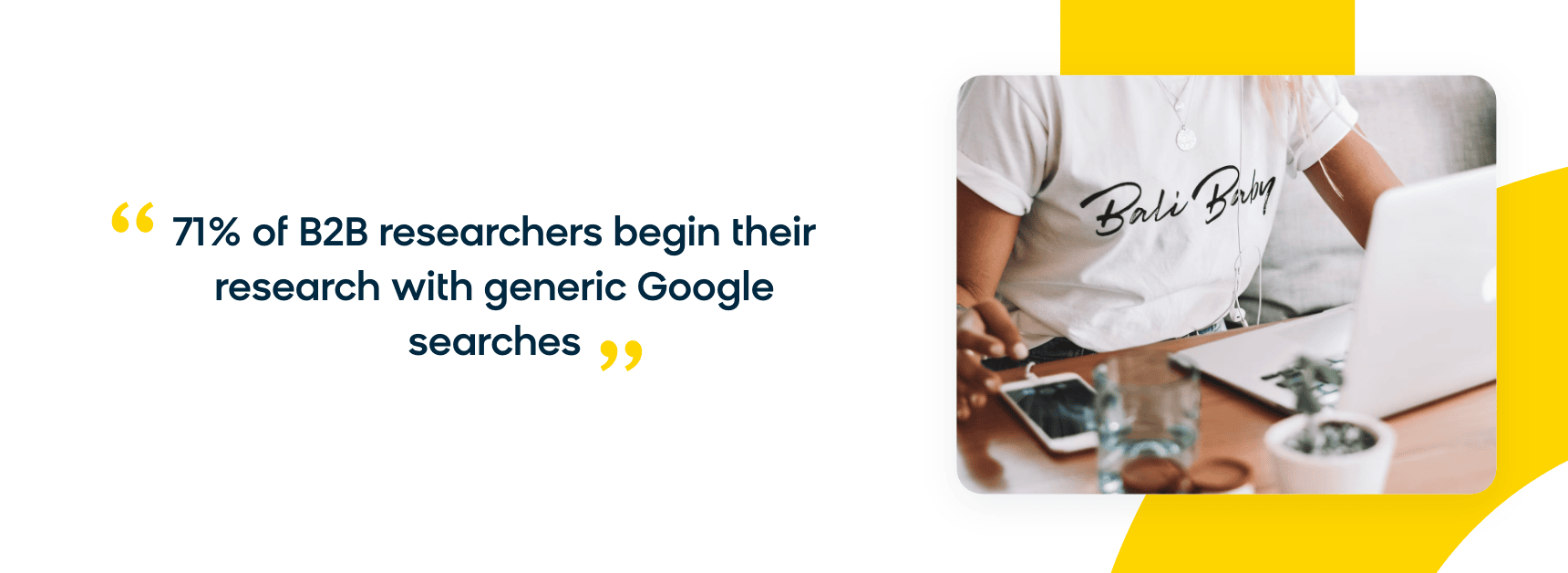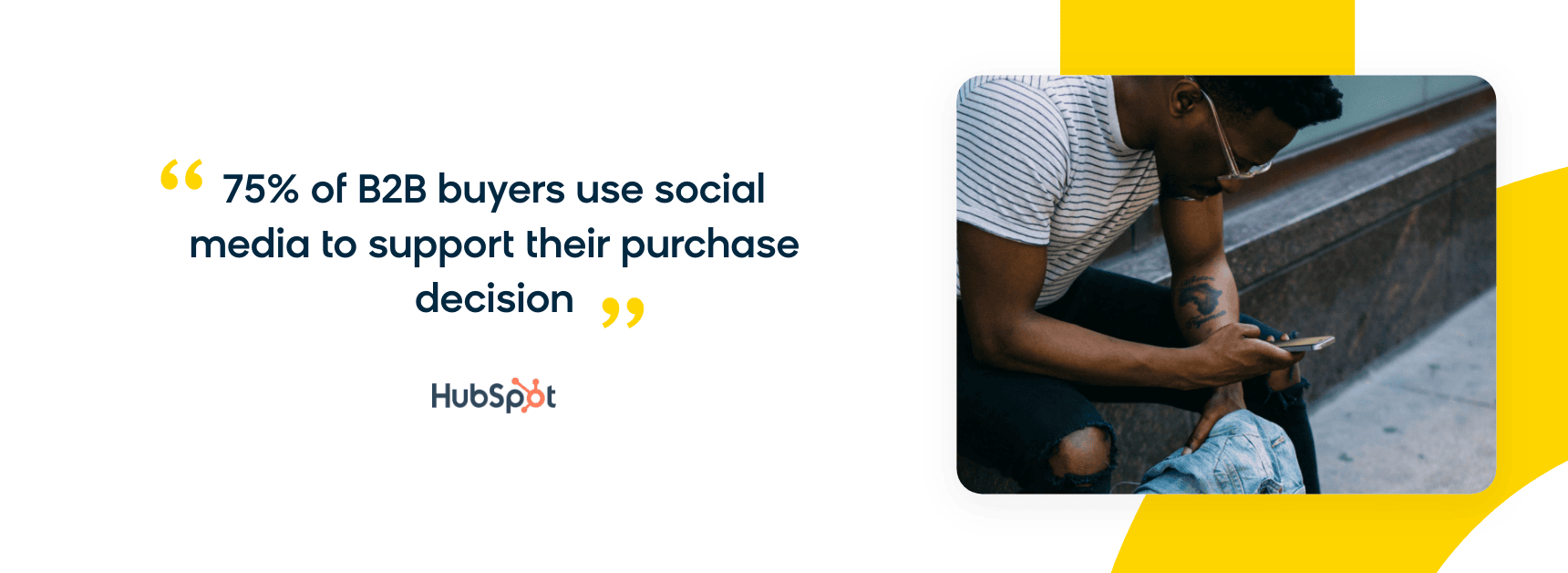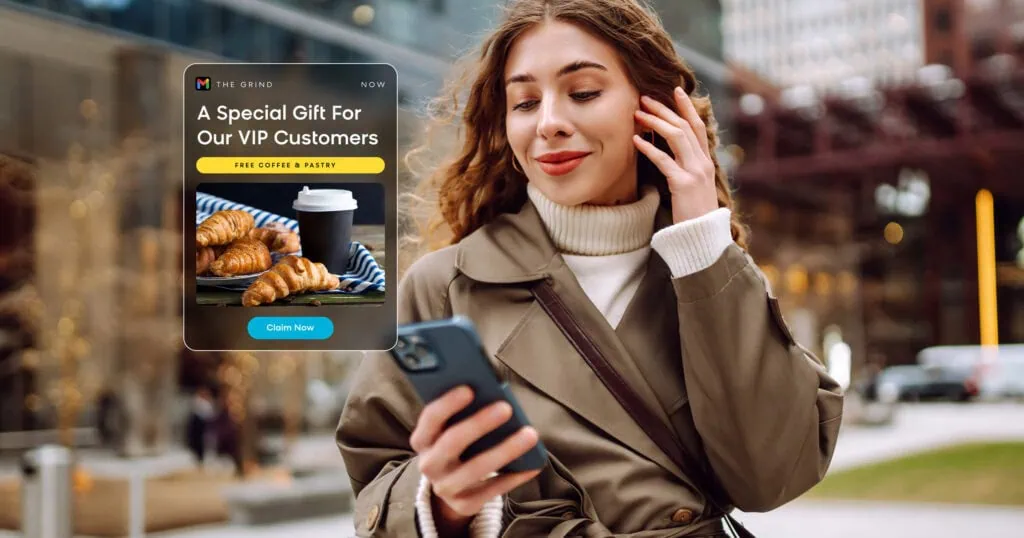If you want to learn about B2B marketing, and where it stands in today’s crowded marketplace, you’ve come to the right place. Let’s explore the topic in-depth to shed light on each element of today’s most effective B2B marketing strategies.
What is B2B Marketing?
B2B marketing is the process of selling to a business person, or a team of people. The Business Dictionary has a nice definition. It describes it as a process by which businesses: ‘employ a multi-layered strategy…for the purpose of converting targeted business prospects into customers’.
The traditional view of B2B marketing is that it’s different to B2C.
- When some think of B2B marketing strategies, they think primarily of direct and outbound techniques.
- Longer B2B sales cycles demand different marketing channels. That makes online shopping, impulse buys, or point of sale less important.
- The sales consultant would also be a key component of B2B. They offer buyers a gateway to much needed information and basically bring in the business.
While much of the above is still true, B2B marketing is not what it used to be. It has evolved and now encompasses many of the same digital marketing characteristics that other businesses in the B2C realm do. The world went digital and that’s spurned big changes in the format and delivery of B2B marketing programs.
The Evolution of B2B Marketing
- The Usual Suspects Are Unrecognizable
For one, the target audience has significantly changed. We can’t talk to buyers like we used to, and we can’t always reach them via the tried and tested channels.
The usual suspects, like CEO’s, CIO’s, or Product Managers are no longer guaranteed to be mid-lifers with years of experience under their belt. Young, tech-savvy millennials are now in charge, people who grew up surrounded by everything the online world has to offer.
They are fast, dynamic and a growing force. By 2025, the workforce globally is expected to be 75% millenial.
This is an audience that’s used to getting things done digitally. For them, there’s simply no reason for work-related tasks to move offline. It’s B2C tools like videos, social media or user-generated content that are better at catching their attention. Moreover, 84% don’t even trust the traditional advertising channels.
- Face-to-Face Still Matters, But Less
The amount of face-to-face B2B selling is in decline. Gartner research finds that B2B buyers considering a purchase spend only 17% of that time meeting potential suppliers. When comparing multiple suppliers‚ time spent with any one sales consultant can be as low as 5% or 6%.
The language of business has evolved too. If you do get face time with a B2B prospect, you may need to re-think what you say. According to Forbes, even sounding old-fashioned could put a company at a disadvantage.
“…….as workplace cultures evolve and millennials constitute the majority of the workforce……..messages that once seemed professional now feel outdated.”
One way you need to communicate is via social media. That means the tone, content and format of messages must suit those channels. Punchy and attention-grabbing has definitely replaced staid and overly-professional when trying to connect with individual consumers.
Today’s B2B Buyer Journey
If the buyer has changed, it makes sense that their customer journey must change too. B2C marketing has been a huge inspiration here.
The basic components of a B2B journey are the same. Buyers still need to become aware of a need, evaluate their options, and come to a final decision. But how that all happens is different.
At every point of this new buyer journey, users expect relevant information and logical, smooth experiences.
Search results, content and messaging must hit the right mark every time, on every channel.
That means connecting multiple systems and combining data to add value every step of the way.
In a nutshell, today’s B2B buyer journey is now not a linear and simple transaction; it is more a looping, multi-person online journey across a typical B2B purchase, revisiting each three stages from awareness to decision.
Awareness Stage
The first B2B buyer’s journey stage is the awareness stage where potential customers are researching products and services or looking for options that could potentially solve their problem or meet their needs.
First, your potential customer acknowledges that there is a problem or challenge they face that must be solved. However, they may not know of the existence of your company. Your marketing strategy is to create awareness for your product or service.
And then, he researches to find a solution to their problem. Solutions are researched predominantly online, with Google being the main starting point.
At a minimum, buyers expect the right information. They expect content that’s useful, relevant, timely – even entertaining; value of your product or service, they are more interested in facts and stats, customer reviews, etc.
Only by standing out and addressing your potential customer’s problem is it possible to hold their interest in a fast-moving online world.
Regardless of how it happens, this is the stage where people find out: Your company exists and what your company does.
Consideration Phase
Once a buyer (or prospect) is aware of your company and knows your company can bring benefit to their business, they are at the consideration stage. This is the second B2B buyer’s journey, and it’s dedicated to considerations and comparison between products and services.
During this stage, buyers are researching potential solution providers online – which means they could be considering your competitors too. The consideration stage is where Sales Consultants should get a chance to influence things. They can step in for further clarification, product demos, and personalized services.
The study shows that only 2% of the customers buy at the initial meeting. The other 98% will only buy once a certain level of trust has been built up.
This is the reason why lead nurturing is essential. It can help you convert more lead into sales and increase the scope of those sales. Invespcro states that companies that excel at lead-nurturing generate 50% more sales-ready leads and nurtured leads make 47% larger purchases than non-nurtured leads.
Decision Phase
This is the final B2B buyer’s journey stage where the potential buyer decides to purchase/not purchase a product or service. By this time, they will have all of the pricing and product information, which can have a big impact on their decision. Lead nurturing has finally translated to lead conversion.
The decision stage of the B2B buyer’s journey is an ongoing process for the B2B consumer. A B2B buyer will tell lots of people how their final selection worked out – digitally and very quickly.
After-sales and loyalty-building programs are crucial to get those good reviews out there – you can be sure the next B2B buyer is reading them.
This where AI-based technologies can save the day. They provide a valuable base of insights marketers can use to stay on the pulse.
Has a new client called customer service, complained online, or browsed new products on the website?
Data like that builds a picture, which B2B marketers can use to offer individual attention, at scale.
B2B and B2C Marketing : Blurred Lines
Over the past decade, there’s been a lot of focus on the digital B2C customer experience. That trend has made its way into B2B, and with good reason.
Improving that experience from average to exceptional can create a 30% to 50% increase in KPIs such as tendency to renew or purchase another product.
There’s a great likelihood that the first connection with a B2B buyer happens online, via an enquiry form, email, or even a social media platform.
Buyers will browse products or services using their own natural language, in their own time and on any device. In essence, they will behave just as they do when buying B2C products.
They will also see what others have to say. If you thought influencer marketing was just B2C, think again. B2B buyers actually consider third party reviews to be more authentic.
People will opt for different channels, with digital playing a leading role. B2B marketers ignore mobile at their peril, buyers won’t necessarily shop from behind a desk in the office.
They could browse vendors on a smartphone while in transit, pause the search, then pick it up later on another device.
Whatever channel they jump to, they want fast information, and personalized content that measures up to expectations.
Key B2B Marketing Strategies and Tactics
The traditional B2B marketing framework is quite circular. Market knowledge is gathered and assimilated. From that a business strategy is pulled together. Marketing tactics and messaging are then lined up and launched upon the world. The results are analyzed, results feed back into the planning process, and it all goes around again.
In a digital age, things are much more scattered. Market knowledge comes from a whole host of different sources. Now, every B2B strategy should contain two components: messaging and channels.
Messaging must work on new channels, many of them fast-moving, dynamic and highly attuned to user needs. Feedback comes in from all over the place, in a multitude of formats – anything from a tweet to a phone call.
Despite the fact that it’s all changed, one thing remains the same – B2B marketing strategies still need the support of a robust marketing framework. That’s not the traditional one which has worked up to now, it’s one powered by technologies like AI and machine learning.
Choosing The Right B2B Marketing Channel
To plan your strategy correctly, you need to understand which marketing channels are most effective for your specific audience.
Winning B2B marketing strategies convert prospects into customers. The marketers behind these strategies choose the right channels and messaging across multiple touchpoints.
Here are some of the most common marketing strategies:
B2B Content Marketing Strategies
Content is king. That might be an overused mantra, but it still rings true. Content marketing is the fuel that feeds all of our marketing programs, be they online or offline.
A B2B content strategy is an essential component of any marketing plan. It’s not simply a matter of churning out great articles or blog posts either. Each piece created must be a targeted, purpose-driven nugget of wisdom, to be shared with suspects, prospects and leads – at the perfect moment.
CMI found that 62% of “most successful” B2B marketers and 59% of “most successful” B2C marketers have a strategy in place.
In spite of the strong connection between documenting a strategy and tasting success, merely 37% of B2B brands and 38% of B2C brands have a documented strategy.
Content tactics for your B2B marketing strategy
- Be helpful
At a very minimum the user should be easily able to consume content on the company and its offerings. Product pages, service descriptions and other information must be clear and quickly found. Adobe does a great job of this, with a landing page that lays out the product options at first glance and backs that up with video content.
Better still, any content presented should be personalized. Netflix is a classic example, recommending content to users based on what they previously watched.
- Be relevant
Content today must also be fresh, updated and highly relevant.
Part of being relevant is seeing what people are reading about. An examination of the content currently being consumed gives an idea of purchase intent. Is a user simply browsing the product category? Are they checking out specific products, or comparing prices?
That’s all valuable information. It directs sellers to the topics and content formats that will engage people at that point in time. Content can even be connected to each stage of the buyer journey.
- Be knowledgeable
Prospects should be able to see why other companies have chosen to work with you. Reports, blogs and testimonials provide proof of that.
An impressive 48% of decision-makers say thought-leadership led them directly to award business to a supplier, so being seen as knowledgeable makes sense.
- Be tech savvy
Again, the support of an open flexible, architecture comes into play. This is one of many reasons why Bloomreach joined the MACH Alliance and supports an open ecosystem. If a piece of content can be published to different devices via open APIs (using microservices) it need only be created once, then simultaneously rolled out out over a variety of channels.
That gives organizations the ability to send the same message, in an array of native formats. Marketers can have a surround-effect in the market, without having to re-create the same content over and over again.
Today, content must cut through all of the competitive noise out there, make a company’s voice heard, and grab a customer’s attention long enough to have an impact. With the backing of smart tech and a strong strategy, it can prevail.
B2B Email Marketing Strategies
The most striking feature of email marketing is its cost effectiveness. Compared to other B2B advertising channels, it’s relatively cheap.
At the same time, when email is done properly it really can deliver. Email is still the channel of choice for marketers across the world as over 4 billion people use email to communicate.
Email tactics for your B2B marketing strategy
- Get to know people
Email is highly personal and super-focused. It involves sending a message to somebody, so it helps to get to know them beforehand. Over a large contact list, that’s a lot of work but it’s essential to really connect, especially with today’s younger audience.
This is the space where data-driven decision making rules. Decisions on customer segmentation, are enhanced with automation. User data can be gathered from across a company’s various systems. That data can be used to create a range of personas, or descriptions of each target. Those personas will drive the format and content of each email sent out.
- Let the machines execute
Technology also does a pretty good job of executing on email campaigns. A great example is the automated nurture campaign. Data can be gathered on contacts who have somehow interacted with the company. Based on that, a selection of emails are automatically sent.
If someone has downloaded a whitepaper, they may want more information on a particular topic. That could trigger an email invite to a webinar, with a ‘sign up for a demo’ call to action.
This progresses B2B buyers along the funnel, while catching leads at the right time. There’s definitely a positive impact on revenues, companies that excel at lead nurturing generate 50% more sales-ready leads, and at 33% lower costs than the norm.
- Look good on email
A B2B marketer can also use email to look good. If new clients get an automated welcome series email, perhaps with an upsell, it shows they are dealing with a company that works fast and efficiently. Existing customers can be asked for feedback, then emailed proof of how it was acted upon. Actions like that build trust and loyalty.
There is even some virality in this tried and tested channel. According to Earnest Agency, 72% of B2B buyers are most likely to share useful content via email. If you email something of interest, a user can go to the trouble of passing it along to a peer. If that information came from you, it’s a good testimonial.
- Track progress
The results of email marketing efforts are also quite easy to see. Because email marketing analytics are very measurable, information is readily available to show how it’s all working. B2B marketers can look at stats like number of emails received, open rates, bounce rates and more for objective feedback on their efforts.
The immediacy of this information supports A/B testing on smaller samples too. Different email subject lines can be tried out to see which one generates the most opens. It becomes possible to see what has an effect in the market, before emailing entire contact lists. Forbes recommends A/B testing for any company emailing 5,000 contacts or more.
With almost 130 business emails being sent and received worldwide per user, per day, the potential is there. The flip side is that content marketers have to make those emails stand out. When they do, it can prove to be very lucrative.
B2B Search Marketing Strategies
If so many buyers start their buyer journey in places like Google, it makes sense to be one of the first companies to show up when they do a search. Search engine optimization (SEO) is very important for B2B marketers to understand and grasp.
Today’s B2B marketer must be absolutely sure their business is found online. That’s a non-negotiable prerequisite to connecting with buyers. That new reality has driven B2B marketers towards search engine marketing (SEM) activities.
Search tactics for your B2B marketing strategy:
- Finding the Right Words
B2B buyers generally have a more specific idea of what they want. Their search terms will therefore be more specific, and they expect search results to be too. So marketers must think of all the ways a user might search for a company’s offerings. They may even be surprised by the words they end up bidding on.
As with all the other channels, the keyword decision is increasingly data-driven. Combined company-wide data from connected platforms and systems will show what words are worth paying for.
This is also a high maintenance channel. Having put all those words in place, they need to monitor, tweak and revise constantly to stay on trend.
- SEO
A company’s website must be easy to find online, so should thought leadership pieces like published articles or blog posts. It’s important then to influence search engines by having the right keywords everywhere.
Companies need to pepper the appropriate keywords throughout their website, blog posts, and any other content they produce. But there’s more to that than meets the eye. Keywords must be weaved into text while preserving it’s informational, creative qualities. HSBC does a good job of creating interesting content, with keywords all nicely put in place.
For average SEO aficionado, that kind of writing may not be their thing. SEO writing is a specialism in itself, so much so that brand journalists are being hired to do the job.
Backlinks are another mainstay of SEO strategy, and connecting to other organizations still works. This can now be extended to connecting with the customer, even getting them to contribute to keyword density.
Customer reviews are a great example. Users will type in keywords to comment on various topics. By doing so they increase keyword density, while benefiting from a helpful, unbiased resource.
- Keyword Advertising
This is where Adwords, PPC (pay-per-click) and the like are used to drive people to the website. Paid search advertising might not seem to fit B2B, but it’s actually a great way to generate leads.
Yes, longer sales cycles reduce the chances of a user converting on your landing page, but they can end up exploring your website. They may ask for information, which puts them firmly in your sales database. From there, it’s possible to build a relationship with them.
So while directly attributable sales volumes might be low, many B2B products have high sales value. That boosts the ROI on clicks that do deliver. Despite a relatively high cost per click (CPC), that ROI makes the investment worthwhile.
- Retargeting
Most of us are familiar with retargeting, having browsed a company’s website, we see ads for that company pop up later on other sites or social media platforms.
Behind the scenes the retargeting cookie we dropped on the first website has kicked into action. It reminds us of a product we previously looked at, or introduces us to similar products. If we haven’t purchased yet, this is a nudge to do so. Retargeting does deliver, website visitors retargeted with ads are 70% more likely to convert.
Businesses also use retargeting to determine what stage of the funnel a website visitor is in. Visitors seeking content are most likely at the top of the funnel, so it makes sense to offer product or company information.
Product page visitors are somewhere in the middle, so why not promote thought leadership pieces, like white papers? Users clicking on brochures or price lists are most likely at the bottom of the funnel. It’s probably time to drive them to case studies and/or the demo sign-up form.
Insights like that allow marketers to provide content that really engages.
It’s all very B2C, but with B2B buyers spending so much time online, the model fits.
B2B Social Media Marketing Strategies
There are many voices out there talking about your product. Imagine being able to unite all those threads into a base of data that supports decision making? Imagine being able to consistently share information that’s interesting and relevant enough to drive people to your website?
Social media tactics for your B2B marketing strategy:
- Be Millennial-Friendly
Social Media is where a lot of this is happening. It’s a great forum to share and gather soundbites. It’s where products can be showcased using video, audio and interactive content. Platforms like Facebook, Linkedin or Twitter can be used to highlight blog posts, or show off the latest infographic.
Sounds like a channel designed for millennials? It is. Any company wishing to connect with today’s B2B buyer has to be able to work it.
- Find Out What to Say
Getting social media right means getting users to tune in. That opens the door to a longer conversation. This is a channel that starts out sharing information, and ends up helping to build a brand.
To make sure they talk about the right things, B2B sellers can do a little research. Something as simple as setting up Google Alerts for important prospects will connect to their latest updates. This tool can even indicate when might be a good time to contact them.
Social media can be a secret weapon for B2B marketers as they work to surprise and delight their target audience. It provides valuable intel. For example, if someone has already tweeted something negative about the company, it helps to know about it. Social media is a great place to connect with leads and enhance the sales process.
Most Effective B2B Marketing Strategies You Should Leverage
Marketers are strategizing differently. The focus is on facilitating each buyer’s specific needs.
That means connecting more back end applications to gather intel on those needs. It’s a company-wide effort. Pretty much every department now owns some part of the customer experience.
If there ever was a paradigm shift to pull B2B marketing out of its silo – this is it.
- Context is Key
An important ingredient for ecommerce personalization is context – what’s going on with a user at an exact point in time? Are they already an unhappy customer? Might they be in the market for similar products?
It’s hard to picture computers being able to pick up on any of that. They won’t necessarily understand that a person browsing Pinterest is at a different stage in the funnel to one seeking product numbers.
But humans have intervened with innovative AI software-based solutions that help computers do these things, and they’ve become really good at them. Customized advice and suggestions can be provided. The Pinterest user could get more information on a particular product category. The product number seeker could be recommended similar products.
By getting the context, marketers can give answers or make proposals that make sense to the user.
- Search Must be Easy
Today, most B2B journeys start out on a browser or a website search bar. According to Forrester, 92% of B2B purchases start with search.
Search must therefore be flexible and intuitive enough to stop communication breaking down at the first point of contact. B2B websites must be able to understand what users want and decipher meanings, whether they are clear or not.
To do that, they need to draw from new sources. They must tap into databases of synonyms, and employ technologies like AI, machine learning and natural language processing to figure out what people want.
Having started the search, B2B buyers will come across a series of vendor websites, tech analysts, IT forums and tech publications. A treasure trove of the latest go-to information sources. In fact, they will do most of the research on products and vendors without even approaching a seller.
For some, that’s actually all they need. The journey barely moves offline. According to Forrester, an astonishing 62% of business buyers say they can develop selection criteria or finalize a vendor list — based solely on digital content.
At this point, the sales team has not even had a chance to introduce the company. The screen is where initial contact is made, making search a component that must be optimized. It’s where today’s B2B shopper begins.
- If It’s Not Personal, It’s Not Relevant
B2B buyers have a lot of online information at their disposal. Despite that, the job of buying didn’t get much nicer.
Documenting needs, building requirements, exploring solutions and picking suppliers is still a big ask. If that’s all on top of the regular day job, it becomes a real hassle.
This does however create an opportunity to win favor by making it all easier. B2B sellers can figure out what it takes to communicate in a personal, relevant way.
To do that they need information. And it’s all there in sources like the CRM, social media, or the website. This Big Data can be gathered, sliced and diced to build a clear picture of buyer needs.
Then it becomes easier to see what actions will work. Maybe it makes sense to adjust the timing of product promotions, highlight certain products, or hide others? B2B marketers can tweak the variables to deliver personalized experiences and recommendations.
The user wins too. When a seller provides an optimized version of the information they need, it reduces the burden. That’s a logical first step towards winning their business.
- Automation is The Only Way
The starting point for strategy building has also changed. Rather than awaiting stats and feedback from previous marketing activities, B2B marketers can use Big Data insights to stay one step ahead.
For your average employee trying to pull all that information together, it’s an unwieldy data overload. But where we might see a mound of data pulled from CRM or ORM platforms, AI and machine learning see important patterns.
These technologies can process data in record time, noting trends and deviations. They do it so well that it’s possible to track, even predict customer needs.
Execution of marketing campaigns also gets easier as mobile, website, social media or other campaigns can be pushed out from one central place, and in the right format for that channel.
After the campaign is done next-level market analysis is possible. All of this, with only a fraction of the man hours that were needed before.
These capabilities need the foundation of an open, headless architecture, something most ecommerce platforms were not built on. But it’s possible to add this via a modular solution that sits as a layer on top of existing systems.
Starbucks is on the cutting edge of using big data, AI and machine learning to direct marketing decisions. There’s no reason why any other B2B brand can’t learn from their success.
Generative AI and B2B Marketing
Generative AI has emerged as a powerful tool in the field of artificial intelligence. By leveraging complex algorithms and deep learning techniques, generative AI is capable of creating original and compelling content that mimics human creativity. From generating realistic images and videos to composing music and writing prose, this innovative technology has revolutionized various industries.
In the realm of B2B marketing, generative AI offers tremendous potential. With its ability to generate personalized and relevant content at scale, businesses can tailor their marketing efforts to meet the unique needs and preferences of their target audience. Whether it’s crafting engaging social media posts, writing persuasive email campaigns, or generating blog articles, generative AI can provide the building blocks for a successful B2B marketing strategy.
One of the key advantages of using generative AI in B2B marketing is its efficiency. With the ability to generate content quickly and autonomously, businesses can save time and resources that would otherwise be spent on manual content creation. This allows marketing teams to focus on higher-level strategic initiatives and frees up valuable time for other important tasks.
Furthermore, using generative AI models enables businesses to maintain a consistent brand voice across various marketing channels. By inputting specific guidelines and preferences into the AI model, companies can ensure that the generated content aligns with their brand’s tone and values. This consistency builds trust and familiarity among customers, reinforcing the brand’s identity and increasing brand loyalty.
However, it’s important to note that while generative AI offers numerous benefits, it should be used as a complement to human creativity rather than a replacement. Human oversight and input are essential to ensure that the generated content meets quality standards, aligns with the brand’s messaging, and resonates with the target audience.
Generative AI presents exciting opportunities for B2B marketers. By harnessing its capabilities, businesses can leverage the power of automation to create personalized, engaging, and consistent content that drives results. As this technology continues to evolve, it will undoubtedly play a crucial role in shaping the future of B2B marketing.
Bringing It All Together With Effective B2B Web Marketing
The core purpose of any B2B marketing effort is to align messaging with buyer interests and needs. When than buyer drastically changes by becoming super digital, sellers need next-level web marketing.
Smart digital experiences are how we bring customers in and grow post-acquisition loyalty. That’s made search, social media, PPC and other such channels a de-facto part of the B2B marketing toolkit.
To support customers’ digital journeys multiple back end applications have to get involved. That means more company departments than ever must handle their piece of the customer journey.
The world has changed, yet most ecommerce platforms are still not designed to handle it. They need help to connect up systems, gather and use data from across the board, and deliver coherent messages across all channels.
That help is available in the form the Bloomreach Commerce Experience Cloud. To learn more about personalization in B2B ecommerce, read this next.
















